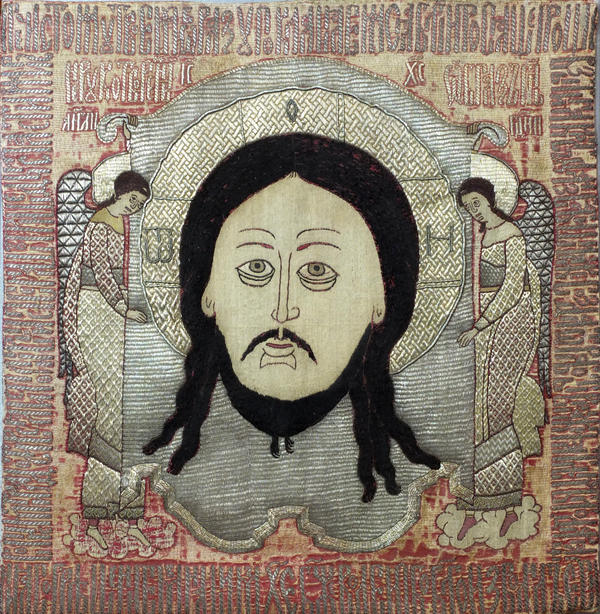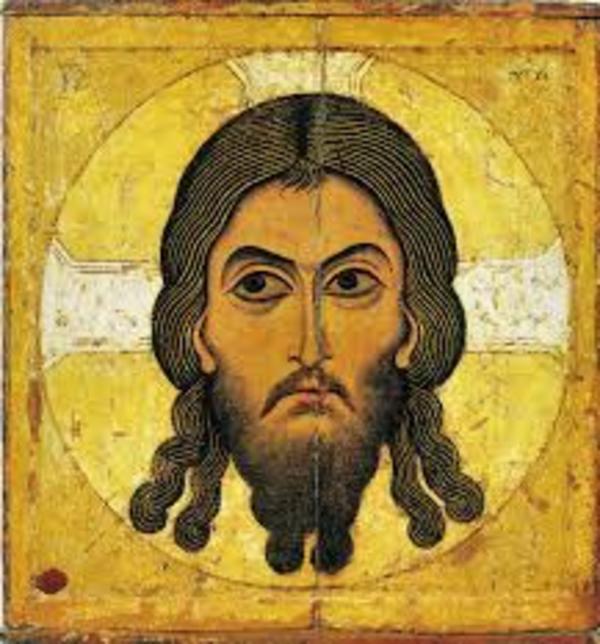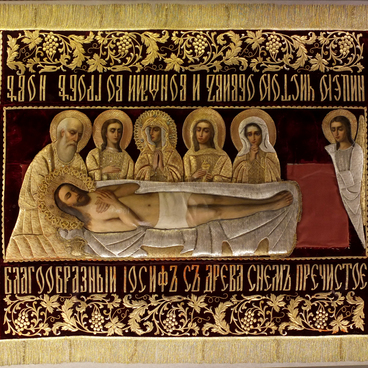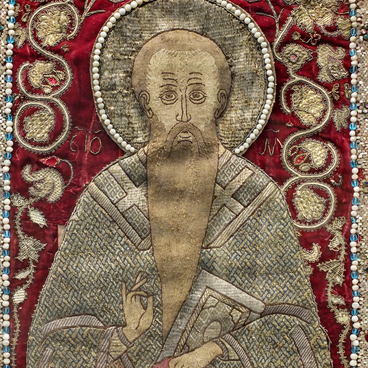The veil is a towel hung under the bottom row of the iconostasis or under especially revered icons, placed on special pedestals or specially decorated places. The veil Icon of Christ of Edessa from the collection of the Uglich Museum was created in the 17th century. It is the embroidered image of Christ that originates from an ancient legend. Allegedly, the face of Jesus was miraculously imprinted on a towel, with which he wiped his face after washing. According to the legend, later this towel cured the king of an ancient state Osroen Avgar V Ukhamu from leprosy and became the first icon in the history of mankind.
On the veil there are embroidered two angels that hold the ubrus — that is the name of the towel in the icon and temple painting. Thus, the master embroiderer emphasized where the image of Christ of Edessa came from. The background images on the veil are embroidered very tightly, which creates the effect of wrought decoration. It is made of gold embroidery — gilded, gold, or artificial silver threads. This technique came from Byzantium and was in use in the church embroidery since the baptism of Russia.
Apparently, the basis of the veil was made by Moscow masters that worked in Uglich in the late 17th and early 18th centuries. Such works were usually products of several masters working together. At first the icon painter would paint the outline of the future image. Then the master-writer would put on the canvas some liturgical text or contribution inscriptions — notes of different contents. After that embroiderers would work on the main image, and herborists would decorate the clothes of saints and the background with plant or geometric ornaments.
Probably, originally the veil Icon of Christ of Edessa was used for the temple icon of the wooden Savior Church. Now in its place there stands the stone church of the Nativity of John the Forerunner on the Volga — from it the veil came to the Uglich Museum in 1922. This temple is considered one of the most important architectural monuments of Uglich. It was erected at the end of the 17th century with the money of the rich Uglich merchant Nikifor Chepolosov in memory of his son John, who died in his infancy.
On the veil there are embroidered two angels that hold the ubrus — that is the name of the towel in the icon and temple painting. Thus, the master embroiderer emphasized where the image of Christ of Edessa came from. The background images on the veil are embroidered very tightly, which creates the effect of wrought decoration. It is made of gold embroidery — gilded, gold, or artificial silver threads. This technique came from Byzantium and was in use in the church embroidery since the baptism of Russia.
Apparently, the basis of the veil was made by Moscow masters that worked in Uglich in the late 17th and early 18th centuries. Such works were usually products of several masters working together. At first the icon painter would paint the outline of the future image. Then the master-writer would put on the canvas some liturgical text or contribution inscriptions — notes of different contents. After that embroiderers would work on the main image, and herborists would decorate the clothes of saints and the background with plant or geometric ornaments.
Probably, originally the veil Icon of Christ of Edessa was used for the temple icon of the wooden Savior Church. Now in its place there stands the stone church of the Nativity of John the Forerunner on the Volga — from it the veil came to the Uglich Museum in 1922. This temple is considered one of the most important architectural monuments of Uglich. It was erected at the end of the 17th century with the money of the rich Uglich merchant Nikifor Chepolosov in memory of his son John, who died in his infancy.






